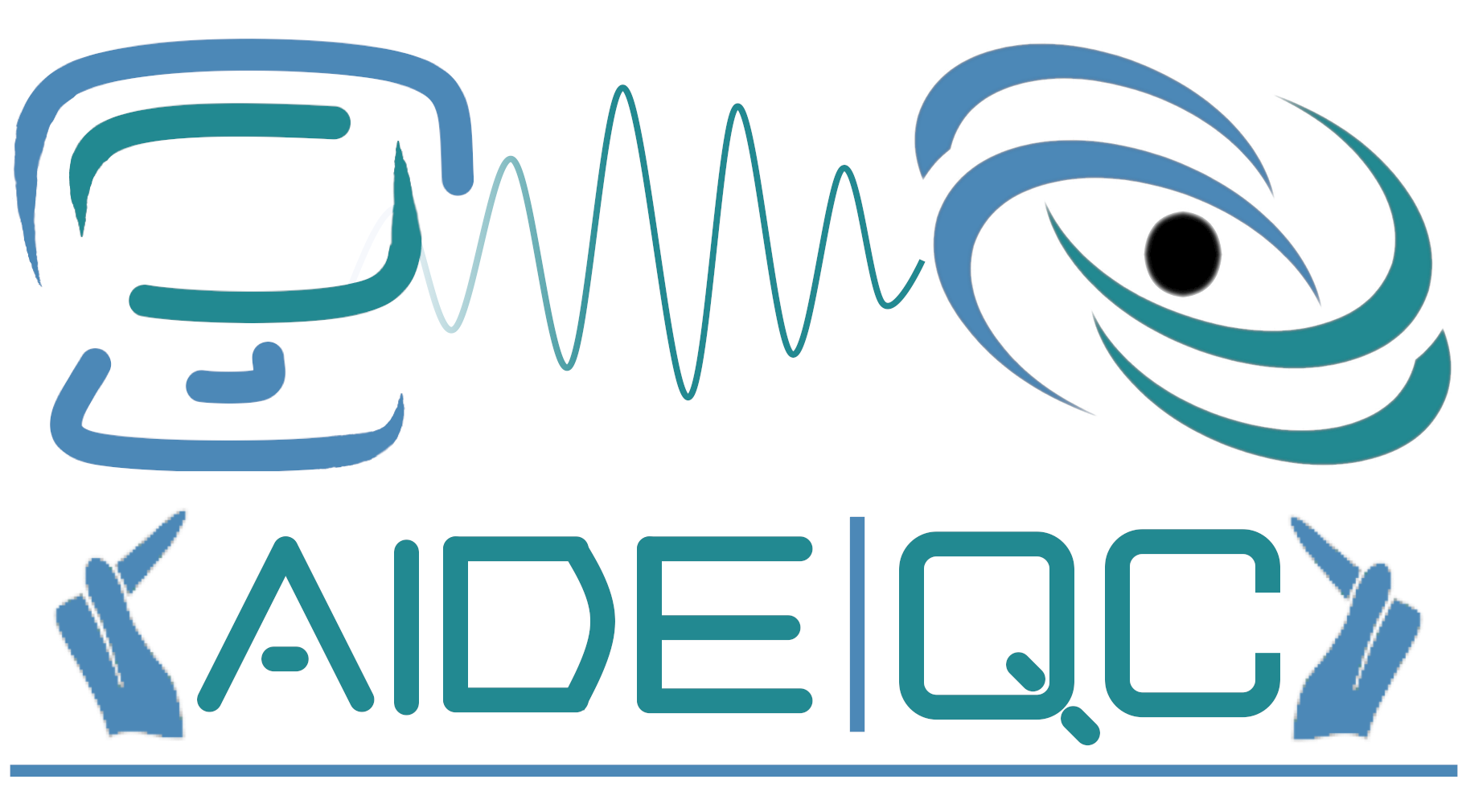Add a New QuaSiMo Workflow
QuaSiMo is a domain-specific library for quantum simulation in the AIDE-QC software stack.
The key extension point of QuaSiMo is its QuantumSimulationWorkflow interface, which is essentially the simulation driver for different protocols/procedures. Please refer to this
page
for more information about QuaSiMo and its components.
Besides its built-in workflow implementations (e.g. vqe, qaoa, etc.), users/developers may want to implement a new workflow (as a plugin) and contribute to the AIDE-QC stack. This section will provide a step-by-step guide on how to create a new QuaSiMo workflow. For simplicity, we use the VQE algorithm as an example, but please note that QuaSiMo already has a built-in implementation for VQE.
Create a New QuantumSimulationWorkflow ¶
The workflow is described via an abstract QuantumSimulationWorkflow class:
// Quantum Simulation Workflow (Protocol)
// This can handle both variational workflow (optimization loop)
// as well as simple Trotter evolution workflow.
// Workflow result is stored in a HetMap
using QuantumSimulationResult = HeterogeneousMap;
// Abstract workflow:
class QuantumSimulationWorkflow : public Identifiable {
public:
virtual bool initialize(const HeterogeneousMap ¶ms) = 0;
virtual QuantumSimulationResult
execute(const QuantumSimulationModel &model) = 0;
};
Similar to
creating a new Optimizer
, to create a new QuaSiMo workflow, one need to subclass QuantumSimulationWorkflow and provide a concrete implementation.
Specifically, we need to provide a name and description string (Identifiable interface) and implement the initialize and execute methods of the QuantumSimulationWorkflow interface. Generally-speaking, initialize is where we parse any user-provided configuration parameters that the workflow supports, and execute is where we run the workflow procedure. This may include constructing quantum circuits, evaluating those circuits to estimate operator expectation values, classical processing and/or optimization, etc.
For example, we create a new custom VQE workflow implementation and name it my-vqe as follows:
// VQE-type workflow which involves an optimization loop, i.e. an Optimizer.
class VqeWorkflow : public QuantumSimulationWorkflow {
public:
virtual bool initialize(const HeterogeneousMap ¶ms) override;
virtual QuantumSimulationResult
execute(const QuantumSimulationModel &model) override;
virtual const std::string name() const override { return "my-vqe"; }
virtual const std::string description() const override { return ""; }
private:
std::shared_ptr<Optimizer> optimizer;
HeterogeneousMap config_params;
};
In the above code, we create a new workflow named my-vqe and add any internal member variables as needed.
As an example, the simplified implementation of the initialize and execute methods are shown below.
bool VqeWorkflow::initialize(const HeterogeneousMap ¶ms) {
const std::string DEFAULT_OPTIMIZER = "nlopt";
optimizer.reset();
if (params.pointerLikeExists<Optimizer>("optimizer")) {
optimizer =
xacc::as_shared_ptr(params.getPointerLike<Optimizer>("optimizer"));
} else {
optimizer = createOptimizer(DEFAULT_OPTIMIZER);
}
config_params = params;
// VQE workflow requires an optimizer
return (optimizer != nullptr);
}
QuantumSimulationResult
VqeWorkflow::execute(const QuantumSimulationModel &model) {
auto nParams = model.user_defined_ansatz->nParams();
evaluator = getEvaluator(model.observable, config_params);
OptFunction f(
[&](const std::vector<double> &x, std::vector<double> &dx) {
auto kernel = model.user_defined_ansatz->evaluate_kernel(x);
auto energy = evaluator->evaluate(kernel);
return energy;
},
nParams);
auto result = optimizer->optimize(f);
return {{"energy", result.first}, {"opt-params", result.second}};
}
As we know, the VQE algorithm requires a classical optimizer hence we need to figure out which optimizer should be used during initialization. In this case, we look for the optimizer key if provided. Otherwise, we just fall back to a default one (nlopt in this case).
Similarly, one may preset (providing default values) and parse any number of configuration parameters that his custom workflow support.
During workflow’s execute, one can take advantage of QCOR API’s to construct the quantum circuit. In this simple VQE workflow, the ansatz circuit was provided as a QCOR kernel functor (user_defined_ansatz), hence, we just need to evaluate (resolving variational gate parameters) during the optimization loop.
One key element of implementing workflow execution is to hook up the appropriate cost function evaluator. In that regard, QuaSiMo provides a utility function getEvaluator which will pick the appropriate evaluator based on user configurations, e.g., selecting the default (tomography-based) evaluator if none provided.
Workflow developers are free to not use the getEvaluator utility if the workflow doesn’t need to evaluate (observe) the operator or requires custom logic in selecting the evaluator.
Workflow developers are free to select which information to be returned at the end of the workflow execution. In particular, the workflow returns a heterogeneous key-value map (dictionary). In the VQE example, we returned the optimized energy value as well as the optimal parameters.
Build and Install ¶
Similar to creating an Optimizer plugin, one needs to provide CMakeLists.txt and manifest.json files to build, register, and install this workflow plugin.
For example, the manifest.json should contain:
{
"bundle.symbolic_name" : "my_vqe_workflow",
"bundle.activator" : true,
"bundle.name" : "QuaSiMo VQE Workflow Implementation",
"bundle.description" : ""
}
Then, we can populate the corresponding CMakeLists.txt
set(LIBRARY_NAME qcor-my-vqe)
file(GLOB SRC *.cpp)
usfunctiongetresourcesource(TARGET ${LIBRARY_NAME} OUT SRC)
usfunctiongeneratebundleinit(TARGET ${LIBRARY_NAME} OUT SRC)
set(_bundle_name my_vqe_workflow)
add_library(${LIBRARY_NAME} SHARED ${SRC})
target_link_libraries(${LIBRARY_NAME} PUBLIC qcor qcor-quasimo qcor-quantum-simulation)
target_include_directories(${LIBRARY_NAME} PUBLIC ${XACC_ROOT}/include/qcor)
xacc_configure_library_rpath(${LIBRARY_NAME})
set_target_properties(${LIBRARY_NAME}
PROPERTIES COMPILE_DEFINITIONS
US_BUNDLE_NAME=${_bundle_name}
US_BUNDLE_NAME
${_bundle_name})
usfunctionembedresources(TARGET
${LIBRARY_NAME}
WORKING_DIRECTORY
${CMAKE_CURRENT_SOURCE_DIR}
FILES
manifest.json)
if(APPLE)
set_target_properties(${LIBRARY_NAME}
PROPERTIES INSTALL_RPATH "@loader_path/../lib;${LLVM_INSTALL_PREFIX}/lib")
set_target_properties(${LIBRARY_NAME}
PROPERTIES LINK_FLAGS "-undefined dynamic_lookup")
else()
set_target_properties(${LIBRARY_NAME}
PROPERTIES INSTALL_RPATH "$ORIGIN/../lib:${LLVM_INSTALL_PREFIX}/lib")
set_target_properties(${LIBRARY_NAME} PROPERTIES LINK_FLAGS "-shared")
endif()
install(TARGETS ${LIBRARY_NAME} DESTINATION ${CMAKE_INSTALL_PREFIX}/plugins)
This is a typical CMakeLists.txt for QCOR/XACC plugins. As usual, please make sure the _bundle_name CMake variable matches the bundle.symbolic_name field in manifest.json.
Also, target_link_libraries and target_include_directories should be modified if one needs to use additional libraries.
Lastly, one needs to register the new workflow plugin so that users can retrieve the new workflow via the QuaSiMo workflow registry (via QuaSiMo getWorkflow function).
In your implementation (.cpp) file, simply add the followings:
#include "xacc_plugin.hpp"
namespace qcor {
REGISTER_PLUGIN(QuaSiMo::VqeWorkflow, QuaSiMo::QuantumSimulationWorkflow)
}
This will inject the necessary code to register your new VQE workflow plugin as a QuantumSimulationWorkflow interface implementation. Hence, QuaSiMo users can retrieve this workflow via the custom my-vqe name that we specified.
Congratulations! You have completed a new QuaSiMo workflow that will be available to all QuaSiMo users (C++ and Python).
 AIDE-QC
AIDE-QC